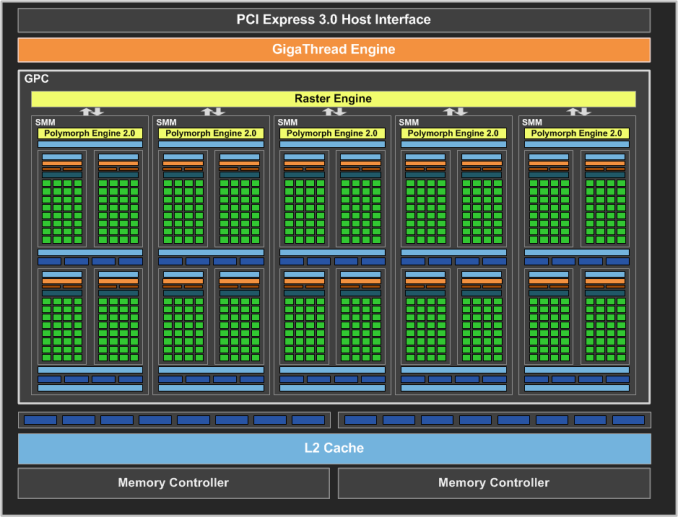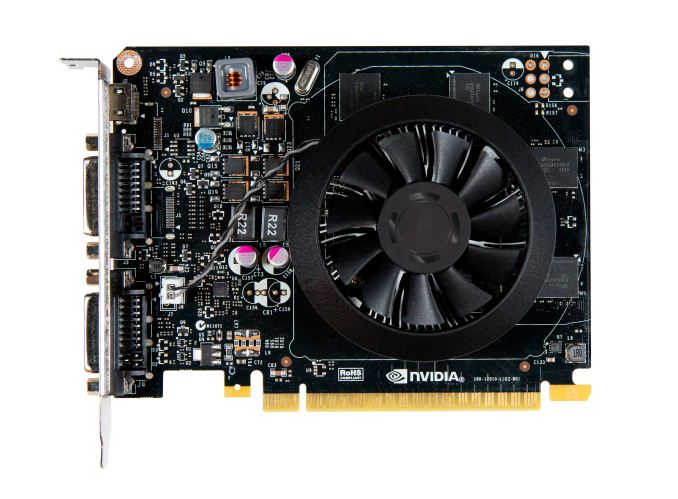The NVIDIA GeForce GTX 750 Ti and GTX 750 Review: Maxwell Makes Its Move
by Ryan Smith & Ganesh T S on February 18, 2014 9:00 AM ESTFinal Words
Bringing this review to a close, NVIDIA’s latest product launch has given us quite a bit to digest. Not only are we looking at NVIDIA’s latest products for the high volume mainstream desktop video card market, but we’re doing so through the glasses of a new generation of GPUs. With the GeForce GTX 750 series we are seeing our first look at what the next generation of GPUs will hold for NVIDIA, and if these cards are an accurate indication of what’s to follow then we’re being setup for quite an interesting time.
Starting from an architectural point of view, it’s clear from the very start that Maxwell is both a refresh of the Kepler architecture and at the same time oh so much more. I think from a feature perspective it’s going to be difficult not to be a bit disappointed that NVIDIA hasn’t pushed the envelope here in some manner, leaving us with a part that as far as features go is distinctly Kepler. Complete support for Direct3D 11.1 and 11.2, though not essential, would have been nice to have so that 11.2 could be the standard for new video cards in 2014. Otherwise I’ll fully admit I don’t know what else to expect of Maxwell – the lack of a new Direct3D standard leaves this as something of a wildcard – but it means that there isn’t a real marquee feature for the architecture to evaluate and marvel at.
On the other hand, the lack of a significant feature changes means that it’s much easier to evaluate Maxwell next to Kepler in the area where NVIDIA did focus: efficiency. This goes for power efficiency resource/compute efficiency, and space efficiency. Utilizing a number of techniques NVIDIA set out to double their performance per watt versus Kepler – a design that was already power efficient by desktop GPU standards – and it’s safe to say that they have accomplished this. With a higher resource efficiency giving NVIDIA additional performance with less hardware, and power optimizations bringing that power consumption down by dozens of watts, NVIDIA has done what in previous generations would have taken a die shrink. The tradeoff is that NVIDIA doesn’t have that die shrink, so die sizes grow in the process, but even then the fact that they packed so much more hardware into GM107 for only a moderate increase in die size is definitely remarkable from an engineering perspective.
Efficiency aside, Maxwell’s architecture is something of an oddity at first, but given NVIDIA’s efficiency gains it’s difficult to argue with the outcome. The partitioning of the SMM means that we have partitions that feel a lot like GF100 SMs, which has NVIDIA going backwards in a sense due to the fact that significant resource sharing was something that first became big with Kepler. But perhaps that was the right move all along, as evidenced by what NVIDIA has achieved. On the other hand the upgrade of the compute feature set to GK110 levels is good news all around. The increased efficiency it affords improves performance alongside the other IPC improvements NVIDIA has worked in, plus it means that some of GK110’s more exotic features such as dynamic parallelism and HyperQ are now a baseline feature. Furthermore the reduction in register pressure and memory pressure all around should be a welcome development; compared to GK107 there are now more registers per thread, more registers per CUDA core, more shared memory per CUDA core, and a lot more L2 cache per GPU. All of which should help to alleviate memory related stalls, especially as NVIDIA is staying on the 128-bit bus.
With that in mind, this brings us to the cards themselves. By doubling their performance-per-watt NVIDIA has significantly shifted their performance both with respect to their own product lineup and AMD’s lineup. The fact that the GTX 750 Ti is nearly 2x as fast as the GTX 650 is a significant victory for NVIDIA, and the fact that it’s nearly 3x faster than the GT 640 – officially NVIDIA’s fastest 600 series card without a PCIe power plug requirement – completely changes the sub-75W market. NVIDIA wants to leverage GM107 and the GTX 750 series to capture this market for HTPC use and OEM system upgrades alike, and they’re in a very good position to do so. Plus it goes without saying that compared to last-generation cards such as the GeForce GTX 550 Ti, NVIDIA has finally doubled their performance (and halved their power consumption!), for existing NVIDIA customers looking for a significant upgrade from older GF106/GF116 cards.
But on a competitive basis things are not so solidly in NVIDIA’s favor. NVIDIA does not always attempt to compete with AMD on a price/performance basis in the mainstream market, as their brand and retail presence gives them something they can bank on even when they don’t have the performance advantage. In this case NVIDIA has purposely chosen to forgo chasing AMD for the price/performance lead, and as such for the price the GeForce GTX 750 cards are the weaker products. Radeon R7 265 holds a particularly large 19% lead over GTX 750 Ti, and in fact wins at every single benchmark. Similarly, Radeon R7 260X averages a 10% lead over GTX 750, and it does so while having 2GB of VRAM to GTX 750’s 1GB.
On a pure price/performance basis, the GTX 750 series is not competitive. If you’re in the sub-$150 market and looking solely at performance, the Radeon R7 260 series will be the way to go. But this requires forgoing NVIDIA’s ecosystem and their power efficiency advantage; if either of those matter to you, then the lower performance of the NVIDIA cards will be justified by their other advantages. With that said however, we will throw in an escape clause: NVIDIA has hard availability today, while AMD’s Radeon R7 265 cards are still not due for about another 2 weeks. Furthermore it’s not at all clear if retailers will hold to their $149 MSRP due to insane demand from cryptocoin miners; if that happens then NVIDIA’s competition is diminished or removed entirely, and NVIDIA wins on price/performance by default.
Wrapping things up, as excited as we get and as focused as we are on desktop cards, it’s hard not to view this launch as a preview of things to come. With laptop sales already exceeding desktop sales, it’s a foregone conclusion that NVIDIA will move more GM107 based video cards in mobile products than they will in desktops. With GK107 already being very successful in that space and GM107 doubling NVIDIA’s performance-per-watt – and thereby doubling their performance in those power-constrained devices – it means that GM107 is going to be an even greater asset in the mobile arena. To that end it will be very interesting to see what happens once NVIDIA starts releasing the obligatory mobile variants of the GTX 750 series, as what we’ve seen today tells us that we could be in for a very welcome jump in mobile performance.












177 Comments
View All Comments
Harag - Thursday, March 6, 2014 - link
Not true at all. The release of the Titan showed they could unlock FP64 performance on a specific architecture. The Titan Black also has amazing FP64 performance. You may also want to look into their Quadro line.kwrzesien - Tuesday, February 18, 2014 - link
Cards are available on Newegg! Check out this EVGA Superclocked (1268MHz) with a dual-fan ACX cooler and 6-pin PCIe power connector: http://www.newegg.com/Product/Product.aspx?Item=N8...Frenetic Pony - Tuesday, February 18, 2014 - link
Maxwell is designed for mobile gaming, in which case who cares? Broadwell looks to improve performance per watt at least as much as Maxwell if Intel's initial hints of 30% power improvement for 14nm and 40% improvement for gpu power efficiency pan out. And they were already damned good.But Maxwell isn't designed for high end, in which case GCN 1.1 and AMD are already beating them for price for performance. Congrats Nvidia, you're second place in both categories if this card is anything to go by. I hope to hell your Titan 2 or whatever kicks more ass than this card.
varad - Wednesday, February 19, 2014 - link
@FreneticPony, statements like "Maxwell is designed for mobile gaming" and "But Maxwell isn't designed for high end" tell us you know precious little. Maxwell is an architecture that will span across all of Nvidia's products [Tegra, GeForce, Quadro and Tesla].Frenetic Pony - Thursday, February 20, 2014 - link
Err... they intend to produce as such yes. But it's obvious the architecture itself is targeted squarely at mobile. Power constraints don't actually get in the way as much as other constraints do on the high end. Who really cares if it's 150+ tdp if it's gaming? You get constrained by memory latency and other things no matter how high you can clock it up.This appears to be Nvidia's version of Haswell, concentrated solely on improving performance per watt rather than performance at all. Which is bad timing as Intel is doing the same, but integrates it's GPUs right onto the chip, making them cheaper and smaller than any dedicated card for a laptop is going to be. Meanwhile AMD is crushing Nvidia in both compute and high end gaming performance on the desktop for performance per $.
True, this will help mitigate electricity cost. for compute based work. But as others pointed out not by much. Meaning Nvidia stuck itself with the wrong focus at the wrong time. Maybe it will help with their Tegra SOCs, if they're lucky they'll get back into the game, as Qualcomm soundly crushed the Tegra 4 for third party ARM Socs over the last year.
So, no, it's designed for high end. Doesn't mean they're not going to do it anyway.
Frenetic Pony - Thursday, February 20, 2014 - link
I.E. it really doesn't matter how well they did at what they're doing. Because Intel has done just as well and has built in advantages for its market, what their doing doesn't help that much against AMD in the high end market, and this leaves their only chance for financial success with it being next years Tegra SOCs.ninjaquick - Thursday, February 20, 2014 - link
Plus, AMD is easily capable of taking Nvidia on at the low end with better hardware across the board, more integrated designs, etc.willis936 - Thursday, February 20, 2014 - link
Pro tip: you're always TDP limited. Increasing performance per watt IS increasing performance.Harag - Thursday, March 6, 2014 - link
Broad statements like "AMD is crushing Nvidia..." only proved @Varad correct. you know precious little.HisDivineOrder - Wednesday, February 19, 2014 - link
nVidia fits a lot more performance in a little more space at a lot less power and you think they're doing poorly? This is on the same node.Imagine what they'll pack into a smaller node.
Their focus is probably the right one, given the fact they want to migrate these cores into Tegra.